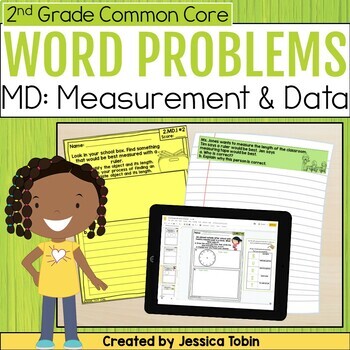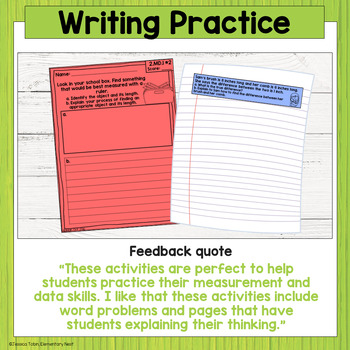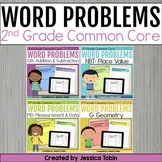2nd Grade Math Word Problems - Measurement, Telling Time, Money, and Graphing
- PDF
- Google Apps™

Also included in
- This is a common core aligned math bundle for 2nd grade. There are four bundles included: worksheets, centers, short answer or word problems, and interactive notebook templates. Each packet included standard-specific activities.There are centers, printables, short answer, and interactive notebook tePrice $67.00Original Price $96.25Save $29.25
- This math word problems bundle is a short answer response 2nd grade practice resource to use when teaching common core math! This is not a curriculum, but a resource to help supplement your lessons! There are between 2 and 5 short answers PER standard to practice towards the end of a unit or beforePrice $15.20Original Price $19.50Save $4.30
Description
This 2nd grade math word problem pack covers the Measurement and Data (MD) standards, which are measurement, telling time, counting money, and graphing. This is perfect to use when teaching students how to answer constructed responses or short answer word problems (which is great for test prep or simply teaching students how to write about their math and understanding).
In this pack, you are able to choose the format that you would like to use for your students.
- traditional worksheets
- cut-and-glue strips for a notebook
- digital slides (Google)
This item aligns with the Common Core standards for the Measurement and Data MD domain, but you don't have to be in a Common Core classroom to use this pack!
Topics Covered:
- Selecting Appropriate Tools
- Measuring Lengths
- Comparing Two Measurements
- Estimating Lengths
- Comparing Two Objects’ Lengths
- Measurement Word Problems
- Number Lines
- Telling Time
- AM vs. PM
- Counting Money
- Money Word Problems
- Creating Measurement Graphs
- Reading and Making Graphs
There is also a word problem strategy page at the beginning. One is a poster to print and keep in your classroom. The other is small bookmarks for students to hold onto while they are learning.
You can save money by buying this short answer pack in a bundle of four other CCSS math short answers!
You can also save even MORE money by buying this pack within the Second Grade Common Core Math Mega Bundle!
Click here for the Math 2nd Grade MEGA Bundle.
Not interested in the bundles? But want more 2nd Grade MD products?
Click here for MD Interactive Notebook.
Like this resource? Make sure to follow my store to keep up with brand-new products!
This purchase is for one single classroom only.
If you're interested in sharing with other classrooms, make sure to buy the extra licenses for a discount through the TeachersPayTeachers tool. If you are interested in a site license, please contact me for a quote at jessica.L.tobin@gmail.com.
CCSS.Math.Content.2.MD.A.1 (2.MD.1)
Measure the length of an object by selecting and using appropriate tools such as rulers, yardsticks, meter sticks, and measuring tapes.
CCSS.Math.Content.2.MD.A.2 (2.MD.2)
Measure the length of an object twice, using length units of different lengths for the two measurements; describe how the two measurements relate to the size of the unit chosen.
CCSS.Math.Content.2.MD.A.3 (2.MD.3)
Estimate lengths using units of inches, feet, centimeters, and meters.
CCSS.Math.Content.2.MD.A.4 (2.MD.4)
Measure to determine how much longer one object is than another, expressing the length difference in terms of a standard length unit. Relate addition and subtraction to length.
CCSS.Math.Content.2.MD.B.5 (2.MD.5)
Use addition and subtraction within 100 to solve word problems involving lengths that are given in the same units, e.g., by using drawings (such as drawings of rulers) and equations with a symbol for the unknown number to represent the problem.
CCSS.Math.Content.2.MD.B.6 (2.MD.6)
Represent whole numbers as lengths from 0 on a number line diagram with equally spaced points corresponding to the numbers 0, 1, 2, ..., and represent whole-number sums and differences within 100 on a number line diagram. Work with time and money.
CCSS.Math.Content.2.MD.C.7 (2.MD.7)
Tell and write time from analog and digital clocks to the nearest five minutes, using a.m. and p.m.
CCSS.Math.Content.2.MD.C.8 (2.MD.8)
Solve word problems involving dollar bills, quarters, dimes, nickels, and pennies, using $ and ¢ symbols appropriately. Example: If you have 2 dimes and 3 pennies, how many cents do you have?
Represent and interpret data.
CCSS.Math.Content.2.MD.D.9 (2.MD.9)
Generate measurement data by measuring lengths of several objects to the nearest whole unit, or by making repeated measurements of the same object. Show the measurements by making a line plot, where the horizontal scale is marked off in whole-number units.
CCSS.Math.Content.2.MD.D.10 (2.MD10)
Draw a picture graph and a bar graph (with single-unit scale) to represent a data set with up to four categories. Solve simple put-together, take-apart, and compare problems using information presented in a bar graph.







